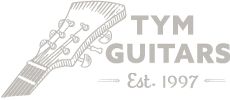Guyatone LG-23 pickup rewind
Share
So as I mentioned recently I finally got my pickup winder going again to repair a whole bunch of vintage pickups I have lying around here after 25 years of ... not throwing stuff out.
While I've got boxes of vintage pickups I've also got complete guitars I've had lying around the workshop because they had shorted or broken pickups. I have started to repair some of these and/or fit new pickups if they were missing parts or I could make one complete original guitar and a hotrod.

This early seventies Guyatone LG-23 is one of several I own with a couple having gone to the shop already but this one had a dead pickup.

I started unwinding the coil, which is where you usually start with dead pickups in case you can find a break close to the end of the coil and repair it, as I did with that seventies Greco Tele (linked above). I'll always try this as if you can salvage the original pickup and coil, that's better for everyone.
I won't go into the full details of winding a pickup. There's HEAPS of sites and forums covering that, but I'll try and do blogs for different types of vintage Japanese pickups I do rewind to give you an idea of what's involved. I'll do a blog on Wide range Humbuckers soon as I have an old Maxon WRHB to repair and some earlier Maxon, later Fujigen and vintage Fender units to compare them to.


I unwound a few hundred turns of this coil and still no luck, so, off came the whole coil.
I took pics of the coil before unwinding to give me an idea of how much physical wire to put back on and measured the original wire, which in this case was #42.
This bobbin set up was used for many different Guyatone pickups utilizing different covers and pole piece set ups to give different looking, and sounding pickups. These square plastic bobbins first appeared in about '67 and were used in A LOT of single coil, and humbucker "looking" Guyatone pickups. I've just rewound an LG-127 metal case pickup with the same bobbin, so more on that soon.

I cleaned everything up and taped the bobbin to the winder. Apart from wire diameter you must also take note of the winding direction. These Guyatone pickups weren't made in "sets" with one pickup being used in all positions without hum cancelling in the centre position, so all these were wound clockwise.
I wound the bobbin to what looked about the "right" size stopping every few hundred winds once I got to around 7000. I ended up stopping at 8000 turns and removed it from the winder.


Because these pickups didn't have collets or attachments on the bobbin for the start and end of the coil, I just leave some extra that I can cut down after soldering lead wires on.
After attaching the lead wires I measured the pickup. Well, not bad really. The original pickup was 6.7K and the new rewound was was 6.9K so pretty well balanced, especially with the new slightly higher one in the bridge position.


Now, of course DC resistance isn't an indicator of what a pickup will sound or perform like, but, with all other variables being the same (wire gauge, bobbin, magnet, poles, cover etc) it is a good indicator that they will be close. Any changes in these variables will of course effect the tone and performance of the pickup but these were (for all intents and purposes) two "identical" pickups with the same wire so this really is "close enough"


With the lead wires insulated and the whole coil tapped and sealed it went back into the cover using all the original parts. Make sure you've got your magnet up the right way here or things will sound wrong once it's all back together.


All in all the rewind worked perfectly and with the guitar set up it was back to play another day and kept it's originality intact. I had considered hotrodding this one as I have a few and I would have liked to hear some mini humbuckers or P-90's in it but, well, the new owner can do that if they wish.

